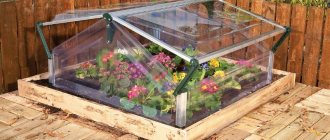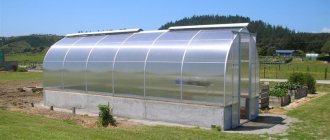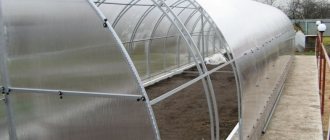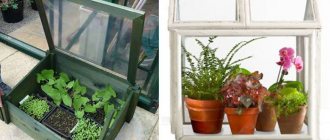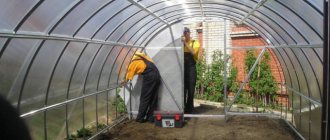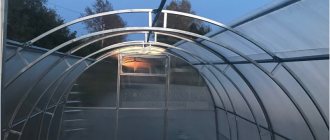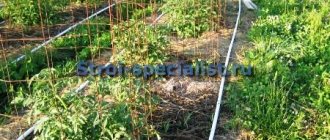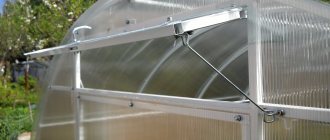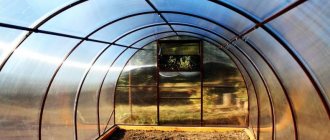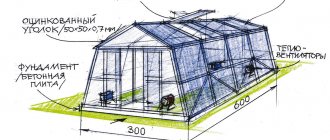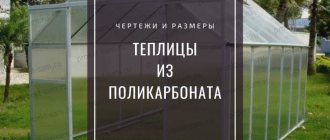Today we will conduct a comparative review of new greenhouses with a sliding roof and with opening sides.
For comparison, we have selected eleven of the most popular greenhouses with an opening top on the Russian market:
- Marusya
- Tulip
- Kremlevskaya-Rublevskaya
- Orion
- Delta
- Flora-Cabriolet
- Nurse-Clever
- Assistant-Gardener
- Sesame
- Sim-Sim
- Gift
Comparison information is taken from manufacturers' official websites and verified consumer reviews.
All greenhouses will be sorted in ascending order by cost of a 6-meter long frame for the period January 2022. Some models cannot be installed without a foundation, so we have added the cost of a foundation or lugs to the price.
So, let's move on to our competitors.
Greenhouse "Marusya"
, Moscow Plant website: https://greenhouses-from-polycarbonate.rf No foundation required. Square profile 40x20 and 20x20 mm. Frame price 6m 24,900 rub.
Advantages: Produced since 2016, during this time several upgrades have been made. It is equipped with Premium polycarbonate 4 mm, density 0.7 kg/m2 with effective UV protection on the surface, service life 15 years. The width of the expanding polycarbonate sheet is 1 meter; if desired, it can be reduced to 65 centimeters. The frame does not rust, is made of galvanized square pipe. The design allows the installation of automatic vents. Inexpensive, repairable polycarbonate guides with UV protection. Collapsible, convenient for transportation.
Disadvantages: Difficulty in self-installation.
Description of design
The Volya company produces many basic and additional models of greenhouse structures. Their sizes and shapes are designed for different operating conditions. As evidenced by reviews on summer cottages, with a small area of land, it is best to use spherical greenhouses. The Volya Orion greenhouse belongs to this category.
Prefabricated greenhouse
Why is this option interesting? Everyone knows that snow and rain linger on a flat roof, which can lead to leakage and even deformation. Sediment does not linger on the slope, which eliminates this threat. The semicircular shape of the roof does not allow rain and dry snow to linger for a minute. Only wet snow can remain here. In addition, this particular shape is resistant to wind, since it does not represent a plane. In addition, spherical greenhouses are not prone to tipping over; a foundation is simply not needed here.
We recommend reading: How to cover a garage roof with roofing felt with your own hands: instructions
Greenhouse elements
Orion is a spherical frame structure with sliding upper doors. The frame is made of a square pipe, the material for which is galvanized steel, which is not prone to corrosion. This is a budget solution. For the elite model - Premium, for example, a special metal profile is used. The standard kit from the manufacturer includes 3 semicircular arches and elements connecting them. The frame is assembled using self-tapping screws, screws and nuts.
Slots for sliding
The length of the base module from the manufacturer is 2 m, width – 3 height – 2.1 m. To increase the design, the manufacturer offers an additional package with extension inserts. Each such module increases the total length of the structure by 2 m. You can find all the necessary components on the official website.
For the coating, cellular polycarbonate with a thickness of 4 mm is offered. For the basic module, 2 sheets are enough. The polycarbonate is fixed with special H-shaped profiles - the kit includes 3 profiles 3 m long. Press washers are used as fasteners.
The manufacturer's kit includes all the necessary fasteners and sealing profile.
The main feature of the design is the retractable roof. In the model, it consists of 1 sheet and moves when opened in any convenient direction. In the more expensive version - Orion Premium, the sliding doors move in different directions.
The second plus is two swing doors with windows. The windows can be opened in any direction at will and can be closed both from the outside and from the inside.
Greenhouse "Orion"
, Dubna Official website: https://teplica.lobachev.org No foundation required. Profile pipe 40*20 mm. Price 3*6m – 26,700 rub.
Advantages: Has been in production for over 7 years, has good user reviews. We offer branded polycarbonate 4 mm "Volya Premium Garant" with a density of 0.7 kg/m2, service life 15-20 years. Rubber seals included. The width of the sliding part is 1 meter. Galvanized. Polycarbonate guides. Collapsible, easily fits in a car.
Disadvantages: Difficulty in self-installation.
Choosing the right material to create a greenhouse frame
You can make a greenhouse with an opening top from almost any material. However, this will largely determine its service life and affect how comfortable it will be to use and how often you will have to deal with the need for repair work. Let's look at the most common materials and their characteristics.
Wooden frames for greenhouses are not used very often, although it is worth recognizing that this particular material is used for this purpose most often than any other. Now they are gradually abandoning it, which is due to its two significant disadvantages: a tendency to rot and dry out. In addition, wood can be a habitat for insects.
A much more durable polycarbonate greenhouse will be obtained if you use a galvanized profile for the frame. This is a very durable material, so a structure made from a profile will not be affected by precipitation and strong winds. In addition, the material is easy to work with, allowing assembly even by one person.
When choosing a material for a greenhouse frame, you should take into account the required service life and the possibility of rearranging the finished structure.
To assemble the frame, you can also use galvanized corners. Thanks to this, the strength of the structure will be extremely high, however, the cost of the greenhouse will be slightly higher. It is precisely because of the extra expenses that summer residents do not use this material too often, especially when it comes to building a small greenhouse for seedlings or greenery.
Another, very convenient, but not so expensive option is metal-plastic pipes. They are very flexible, making them easy and convenient to work with, giving them the desired shape. The finished structure will be light in weight and, if necessary, can be easily moved to another location.
On a note! If you need to make a temporary structure, and at the same time you need to spend as little money as possible on it, then the ideal option would be to use plastic pipes and plastic film.
If you value reliability and durability, then you should pay attention to aluminum pipes. This is a rather expensive material, which, nevertheless, can last for many years. But such a structure should not be installed in an uncovered and unguarded area.
If wood is used in the construction of a greenhouse, it is worth taking care to coat such elements with a special wood paint for exterior use.
Greenhouse "Flora-Cabriolet"
, Vladimir region. Factory website: https://7teplic.ru The frame is galvanized or painted. Profile 20 mm. The roof is removable. A foundation is required. The frame costs 28,000 rubles. + foundation for 4500 rubles = 32500 rubles.
Advantages: Straight walls – more usable area. You can order a galvanized frame.
Disadvantages: The painted frame will rust over time. Welded, welding seams rust. High walls have greater windage. Bulky, inconvenient to transport in a car. Not convenient to use. The edges of the removable roof are located at a height of 2 meters, making it difficult for short people to use. Before winter, it is necessary to completely remove the roof and put it away, and in the spring, insert a long three-meter sheet into the guides in place; this requires two tall people and a free space of 2-3 meters on one side. The length of the polycarbonate sheet on the roof is 3 meters; you need to have a free space of 2-3 meters on one side to use it. In summer, the sheets cannot be extended more than 20 cm, otherwise the wind will fray the free ends and may even tear them out of the guides or break them. There are no seals, the heat will escape through the cracks. The kit does not include high-quality, durable polycarbonate. Greenhouses “Flora Cabriolet” are equipped only with cheap polycarbonate from the KS Profplast plant without UV protection on the surface in the form of a film, but only “in bulk”. Such polycarbonate can be destroyed by the sun within 5 years. The walls are covered with weak, “lightweight” polycarbonate with a reduced density. Difficulty in self-assembly.
How to position the greenhouse?
Buying a good greenhouse is only half the battle. In fact, in order to provide plants with good conditions for growth and development, you also need to install the structure correctly - a lot will depend on this. Often a greenhouse is placed where it fits, without thinking about how it is located or whether it is in the right place. You can often see a structure where, in fact, it will be of no use - plants will not grow in the absence of light or in areas of strong drafts, etc.
So, the greenhouse should be oriented east or south. This will allow the plants to receive the amount of light they need and the crops will grow better. Also, in general, the area for it should be well lit, not be shaded by trees, house walls, etc. You should not place the structure in a windy place - strong winds can destroy it, and it will be difficult to ventilate the plants. Access to the greenhouse itself should be convenient for the gardener - this is also an important factor. Nothing should prevent the doors from opening freely.
Polycarbonate greenhouses
Greenhouse Botanist “Tulip Antistorm 2021”
Production: "AGS-Service", Republic of Belarus Website: https://ags-agro.by Top and sides move apart. Installed on the foundation. Profile 40x20 mm. The cost of a frame 6m long is 41,700 rubles.
Pros: Opening top. Galvanized.
Disadvantages: Large windage of 2-meter sliding polycarbonate sheets. Polycarbonate is a soft, elastic material, with such windage it can be torn out by a gust of wind. There are no rubber seals around the cracks through which heat escapes. In winter, snow gets into the cracks between the opening roof and the sides, bursts the polycarbonate and squeezes it out of the guides.
When installed without a foundation, on piles, due to large spans, skew and polycarbonate may fly out of the guides.
The guides are made of plastic containing various additives, vinyl chloride, which upon contact destroy polycarbonate over several years. Factories prohibit contact of polycarbonate with PVC, and you lose the warranty from the SPK manufacturer. Difficult to install. The profile guides are not transparent, the frame is not visible through them, which makes it difficult to secure them with a self-tapping screw exactly in the center and the sliding elements get wedged as a result. Thick plastic guides and metal frame have different coefficients of thermal expansion. In winter, the plastic loses elasticity in the cold and becomes rigid, the guide pulls the screw out of the metal and, as a result, gaps form between the frame and the guides.
Expensive replacement of guides in case of breakdown; they can only be purchased from the manufacturer in Belarus; in Russia, greenhouse sellers currently do not sell guides separately. Bulky, inconvenient to transport in a car.
Types of greenhouses with an opening top
You can make a greenhouse with your own hands, but you can also buy a ready-made one. In stores it is now easy to choose the one that seems most optimal both in size and design.
It is worth noting that there are several models of greenhouses of this type. For example, they can be categorized by roof type. The most popular option is a greenhouse with an arched roof . Moreover, due to the fact that polycarbonate bends well, it is not difficult to make such a roof from it. It will have the shape of an arch. Thanks to the presence of this design feature, precipitation will not accumulate on the roof, which means that in the winter you don’t have to worry that snow will push through the greenhouse and damage it. Also, condensation accumulating on the inside of the roof will flow down without falling on young plants and without irritating them. The only disadvantage of an arched greenhouse is that only short plants can be grown in it.
Arched greenhouse
Droplet greenhouses are similar to arched ones. They have a streamlined shape, but the upper part of the roof is equipped with a “ridge”. Such a roof also prevents precipitation from accumulating. But such greenhouse options are rare - greenhouses are usually made in droplets.
Greenhouses are common structures for growing seedlings and heat-loving crops
A greenhouse can also have a gable roof . It can withstand fairly heavy loads very well. The greenhouse itself in this case has clear geometric shapes of a rectangle or square. The best option for growing relatively tall plants. But such a greenhouse is more expensive than other models due to the complexity of manufacturing the structure.
Gable greenhouse
Greenhouses with a pitched roof look like a box, closed on top with the same polycarbonate. In this case, the lid simply folds up when necessary. Typically the structure is located near the walls of a house or other building. However, the sun penetrates into it only through the top, so some crops may lack lighting. And the roof itself is capable of accumulating precipitation, as a result of which it needs to be constantly cleaned, and especially in winter, otherwise there is a risk of damage to the polycarbonate.
Lean greenhouse
There are also domed greenhouses with an opening top . Usually their roof is made of triangular segments connected to each other. This option allows you to disperse light well and evenly inside the greenhouse. The greenhouse doors can either be folded back completely or be partially open.
On a note! You can make a greenhouse of absolutely any shape with your own hands. But it’s easier to buy the selected design option. Fortunately, greenhouses cost far from exorbitant amounts of money. Factory-manufactured options are presented below.
Greenhouse-breadbox
Table. Types of ready-made greenhouses.
| Type | Description |
| Breadbox | The name was formed due to the fact that the greenhouse resembles in its appearance an ordinary breadbox. Its roof is arched and, if necessary, one of its wings can simply be moved upward, like the ancestor of the name - the bread bin. |
| Snail | This option is also a greenhouse with an arched roof. If necessary, both doors of the structure can be opened and access to plants and soil for work. |
| Butterfly | This greenhouse is similar to the bread bin described above. But the doors should not be moved, but opened to the sides and upwards. A greenhouse with open doors resembles a butterfly with its wings open - hence the name. Also, such a greenhouse is sometimes called a “zucchini”. |
| Belgian | This greenhouse is rectangular or square in cross-section and has a roof with one slope, less often with two. If necessary, it can be easily lifted up and accessed to the plants. |
Any factory greenhouse usually has an aluminum frame and polycarbonate lining. Thanks to the use of these materials, it is a lightweight and mobile structure that can be easily moved to another location or disassembled if desired.
Butterfly greenhouse covered with cellular polycarbonate
Find out how to make a canopy over a polycarbonate porch, and also read the installation instructions in a special article on our portal.
Greenhouse "Sim-Sim"
Produced by Greenhouses of the North LLC, Cherepovets. In 2020, the plant stopped producing this model. A copy of the Sesame and Tulip greenhouses with all their shortcomings. Installed on the foundation. The width of the transoms is 2 meters. There are two options: The first is from a 40x20 mm profile. Copied from the Tulip greenhouse. The second is made from a 20x20 mm profile with a double arc, a copy of the “Helper-Gardener” and “Sesame” greenhouses. In 2022, a 6-meter frame cost 25,100-27,000 rubles. + foundation made of timber 3000 rub. + you need to buy lugs for the timber (at least 1 piece every 2 meters).
The same as for all greenhouses with opening sides. Large windage, loose polycarbonate sheets are torn out of the guides by strong winds, and in winter they are also squeezed out by snow.
To reduce the final cost of the Sim-Sim greenhouse, the Greenhouses of the North plant equips its frames with cheap, lightweight, 0.55 kg/m2 density, without UV protection on the surface, 4 mm polycarbonate. Such polycarbonate with so-called UV protection “in bulk” can begin to deteriorate after just three years. Complex and time-consuming assembly. There are no rubber seals around the gaps through which heat is blown out. “Crab system” for attaching pipes (it becomes loose over time). The guides are made of plastic and may begin to crumble after a few years when exposed to the environment. Replacing broken guides is expensive and can only be purchased from the manufacturer. According to reviews on the forum, the lower side parts of the Sim-Sim greenhouse are difficult to open. Welded, seams may rust. Bulky, requires a truck for transportation.
Building a greenhouse - choosing a location and planning beds
For a greenhouse made of glass and aluminum, you need to choose the right place where vegetables, berries, flowers and seedlings will be provided with the best conditions for growth. The most important condition is the absence of objects that prevent sunlight from reaching the crops inside. That is, the greenhouse should not be shaded on the southern or eastern side by trees, tall bushes, houses and fences - place it at a sufficient distance from them (usually 3-5 m).
Choosing a place for a greenhouse
How to install a greenhouse according to the cardinal directions
In addition, the building should not be heavily ventilated - the heat will leave it too quickly. Also, in the presence of drafts, the risk of various diseases in plants increases. Therefore, do not place a greenhouse between two tall buildings, and also make sure that it is covered on the north side by a fence or a row of trees, but at some distance.
Also, do not forget to examine the soil on which the building will be placed - is it hard enough? If the ground is subject to heaving and other movements, then a deeper foundation will be required - possibly using metal or concrete piles.
Having chosen a suitable site, begin drawing up an initial plan, which will also include planning the beds inside it. The table below will help you in this matter.
Table. Basic layout of beds in a greenhouse.
| Title and photo | Description |
In two rows | The classic scheme - the entrance to the greenhouse is located in the center of the end, from where there is a 60-70 cm path, beds on the left and right. Keep in mind that their width should not exceed 90-100 cm, otherwise there will be problems with caring for plants and harvesting. |
Three rows | A further development of the two-row scheme is used for wider buildings. The left and right beds are located along the side walls. The entrance to the greenhouse is located at the end, two paths go from it, and between them there is a central bed. In most cases, the latter is wider than the side ones, because it is possible to get close to it from all sides. But there is an alternative layout option in three rows - wide beds on the sides, and in the center - narrow racks with seedlings or small-sized bushes and root systems of agricultural crops. |
U-shaped in two rows | When placing beds in two rows in the greenhouse, a “dead zone” remains at the end opposite the entrance. With a U-shaped layout, this location will be used. But this scheme has one drawback - access to plants in the corners of the building from the side opposite the end will be somewhat difficult. Therefore, it makes sense to make the jumper in the U-shaped scheme a little narrower than the main beds on the sides. |
U-shaped in three rows | An attempt to combine the two previous schemes into one. The result is a very efficient use of the interior space of the greenhouse, but it must also be wide enough. In addition, the paths between the beds are narrow, so care should be taken when working and harvesting. |
With a side entrance to the greenhouse | The entrance to the greenhouse is located on the side, the beds are placed along the perimeter of the walls of the greenhouse. The scheme is characterized by high space efficiency. Not suitable for arched buildings. |
With a side entrance to the greenhouse and a “dressing room” | For winter greenhouses, the previous scheme can be supplemented by attaching a kind of “dressing room” to the door. It will prevent drafts and “freezing” of plants when entering and exiting the building. |
An example of placing shelving in a greenhouse
For medium-sized and large greenhouses, a three-row arrangement of beds with two aisles is allowed
Heating of plants and their root system in a greenhouse can be ensured not only with the help of a “warm floor” system or fans, but also in a natural way - by creating compost beds. In most cases, they are boxes made of wood, slate or brick. Inside, they are successively filled with several layers of organic material, from larger to smaller, and on top everything is sprinkled with fertile soil. Over time, a rotting mechanism starts in such a bed, and the result of the reaction is the release of heat, which warms the roots of the plants. In addition, decomposing organic matter feeds planted crops with useful substances.
Sectional construction of a permanent warm bed for a greenhouse
In some cases, part of the compost bed can be placed below ground level. With such thickness and amount of organic matter, it is capable of providing plants with heat and nutrients for 3-4 years
Video – Aluminum garden greenhouse ASG
Sunny vegetarian Ivanova
The solar vegetarian is an invention of physics teacher A.V. Ivanov, who implemented the idea of maximizing the use of solar energy in a greenhouse. The design allows you to maintain temperature, humidity and air composition without complex and expensive systems.
Greenhouse "Delta"
, Dubna Since June 2022, the plant no longer produces. The roof is removable. No foundation required. Profile pipe 20x20 mm. The price of the frame is 37,500 rubles.
Advantages: Galvanized. Polycarbonate 4 mm Premium with a density of 0.7 kg/m2, service life 15-20 years. Rubber seals included. “House” shape with straight walls. Polycarbonate runners. Collapsible, takes up little space.
Disadvantages: The complex roof structure, which consists of two parts and is latched in the middle, requires additional time to assemble it yourself. It is demanding on the condition of the soil; when installed on a heaving and swampy area, it is better to mount it on a foundation. In summer, it should not be opened more than 20 cm.
Making a greenhouse
In fact, if you have time and desire, and also in order to save money, you can make a greenhouse yourself. Materials such as polycarbonate and polyethylene film are suitable for this. But the first has an undeniable advantage over the second, since it is more durable and stronger. The film usually lasts for 1-2 seasons at most, after which it either breaks or becomes so worn out that it no longer really allows light for the plants inside the greenhouse. The easiest way is to buy polycarbonate sheets and make a greenhouse out of them.
Scheme of a lean-to polycarbonate greenhouse
Wooden slats or an aluminum profile can be used as a frame. The latter, if desired, can be bent and made into an arched structure. An aluminum profile is much better than wood in the sense that it will not become a breeding ground for insects living in wood, and will not become a place for mold and rot that are dangerous for plants to appear. But working with wood is, of course, easier.
DIY greenhouse made from scrap materials
Having assembled and installed the frame on the foundation, it is enough to cover it with film or sheathe it with polycarbonate and that’s it. The greenhouse is ready for use. But it is much easier and more time-efficient to purchase a regular ready-made greenhouse, which is easy and simple to assemble yourself.
Greenhouse "Kremlevskaya Rublevska" with opening roof and sides.
Production "New Forms", Kimry. At the end of 2022, the plant stopped producing this model. Installation on a foundation or on piles. Double profile 20x20 mm. Price in 2022: frame 6 meters 24,300 rub. + pine foundation 3000 rub. + lugs 1 set (4 pcs.) 600 RUR, you need to buy at least 2 sets.
Advantages: Galvanized frame. There is a wide selection of SPK varieties; the assortment also includes expensive, high-quality polycarbonate, just suitable for sliding greenhouses.
Disadvantages: The Rublevskaya greenhouse with a sliding roof and sides is a simplified version of the Kremlevskaya greenhouse, it has only three longitudinal lintels. Mounting on "crabs". The opening sides and 2-meter-wide sliding roof have a large windage area; strong winds can tear the soft polycarbonate out of the guides, making it difficult to insert back. When polycarbonate moves up and down, the protective layer from ultraviolet radiation on the lower sheets can be worn off due to friction, which will lead to its rapid deterioration. When condensation forms on the inner surface of the greenhouse, the wide sheets of SPC stick, and the sides will not rise until the top dries. The rising sides are quite heavy for older people. Difficult to assemble.
Useful tips for installing a greenhouse
The yield that you can get from a greenhouse without a roof depends on many factors, for example, on its location. Therefore, it is worth paying great attention to the installation of the structure.
It is important to correctly position the opening greenhouse on the site Source homeli.ru
Here are the basic principles for installing a greenhouse:
- The area where the greenhouse is located should be sunny and not subject to drafts , then the room will quickly warm up.
- You should not place the greenhouse next to trees , because leaves and fruits will fall from them, and the crown will block the sun .
- Before installation, you need to level the site so that the greenhouse does not skew. It is better if the soil is hard .
- It is more rational to locate the greenhouse near the harvest storage areas and close to the water supply .
- You should not place the greenhouse right next to the garden bed , because then you will have no access and no room to work.
Greenhouse "Helper-Gardener"
Manufactured by "World of Greenhouses", Yaroslavl. In 2022, the plant stopped making this greenhouse. The roof and sides extend. Installed on the foundation. Profile 20 mm. Price in 2022 – frame 6 meters = 32,200 rubles. + timber foundation 2500 + lugs (1 piece – 200 rub.)
Pros: Opening top.
Disadvantages: The disadvantages of the Helper Gardener greenhouse are the same as those of the Tulip greenhouse. Large windage, loose polycarbonate sheets are torn out of the guides by strong winds, and in winter they are also squeezed out by snow. There are no rubber seals around the gaps through which heat escapes. “Crab system” for attaching pipes (it becomes loose over time). The guides are made of plastic; they can begin to crumble after a few years under the influence of the environment, and replacing them is a problem, expensive and time-consuming. Difficult to install. Bulky, inconvenient to transport in a car.
Advantages of greenhouses
Before you decide to buy or build a greenhouse with an opening top, you need to get acquainted with its advantages . Most of the items on the list below are generally suitable for any type of greenhouse.
- simplicity and ease of use;
- small size and compactness;
- low cost;
- preserving the soil from drying out;
- mobility and the ability to move to any place in the summer cottage;
- ease of maintenance;
- the ability to ensure the process of natural pollination and natural soil moisture;
- durability with careful handling.
Such greenhouses have a number of advantages
The main disadvantage of any greenhouse, which, in fact, cannot be called a disadvantage as such, is its small height. That is, it is not always possible to replace a greenhouse with it. Much will depend on what crops are planned to be grown. After all, you can even plant tomatoes of low varieties.
Greenhouse "Sesame"
Manufactured by Rosteplitsa, Dedovsk. The greenhouse is no longer produced. The tops of the sides move apart. Installed on the foundation. Profile 20 mm. A frame of 6 meters costs 32,200 rubles. + timber foundation 3500 + lugs 1 piece – 200 rub. (at least 1 piece is required every 2 meters).
Pros: Sliding top.
Disadvantages: The Sesame greenhouse is similar to all greenhouses with an opening roof and sides and therefore has the same disadvantages. The 2-meter expanding polycarbonate sheets have a large windage and can easily be torn out by a strong wind. Heat loss due to the lack of rubber gap seals and the “Crab system” becomes loose. Replacing broken guides is expensive. Difficult to install. Bulky, impossible to bring in a car.
Tilt angle
In order to use the greenhouse as efficiently as possible, it is necessary to choose the correct angle of inclination of its roof. This is especially important when constructing the structure yourself.
As a rule, a single-pitch or gable roof is installed.
An angle of inclination that is too small leads to a lack of “sloping”, while an angle that is too large makes the roof high and the temperature inside the structure insufficient.
Experts consider the optimal angle of inclination to be 20-25 degrees, since such roofs:
- let in more light;
- promote uniform distribution of solar energy;
- do not retain snow and other precipitation;
- do not leak;
- dry quickly;
- easy to clean.
A properly selected roof not only extends the life of the structure, but also provides optimal conditions for obtaining a good harvest.
Greenhouse "Present"
, Dubna. In 2022, the plant stopped producing this model. No foundation required. Profile 33x33 mm. The frame costs 37,800 rubles.
Advantages: Polycarbonate 4 mm with a density of 0.7. The frame has a 1st class metal anti-corrosion coating on the outside and inside - 275 g of zinc per square meter. Anti-corrosion guarantee 15 years! Rubber seals included. The width of the sliding part is 1 meter.
Disadvantages: Highest price. Complex and longer to assemble than all other greenhouses with an opening roof.
How to choose a place for “Clever Girl”
To install the structure, you need to choose the right place. Manufacturers advise taking into account the following requirements when choosing.
- The place should not be in the shade, which means away from buildings (at least 5 m).
- The greenhouse is highly durable, but if a fallen tree falls on the structure, it will not be able to stand. Therefore, the greenhouse should not be installed closer than 3 m from the trees growing on the site.
- The structure should “look” in the south direction of one of the long walls - this will allow the structure to warm up as much as possible.
Diagram of the correct location of the greenhouse
Greenhouse “Nurse-Clever – Standard”
Manufactured by Metal Service, Novosibirsk. – the plant closed in 2019. Profile 20 mm. The roof can be opened with a winch. Foundation required, not included. Frame price from 19,400 rubles. + the cost of your foundation + lugs 1 pc. – 250 rub. (for reliable fastening of a frame 6 meters long, a minimum of 8 hooks are required)
Pros: The roof opens and closes quickly. Galvanized.
Disadvantages: Requires the purchase of a foundation. There are no dealers in the regions; frames are sent throughout Russia by a transport company. Difficult self-assembly. It is impossible to open part of the roof, for example, in the middle or along the edges, you can only open the entire roof at once. The winch may break.
Do-it-yourself compact greenhouse with a roof: important details
Before assembling the greenhouse structure, you need to decide on the location for its placement. The area must be cleared of roots and bushes, the layer of soil must be leveled as much as possible.
To strengthen a stationary structure, you need to prepare a foundation. Solid - if the greenhouse is large, strip - for a small greenhouse.
The place should be quiet, hidden from the wind. There should be no buildings or tall trees near the future greenhouse that could obscure the sunlight. The right location is the key to a great harvest!
The construction of a greenhouse with a removable top is practically no different from a regular greenhouse. The only difference is the installation of the roof top, which will tilt or slide. As a rule, polycarbonate sheets are mounted in special grooves. If necessary, part of the greenhouse can be folded up or part of it removed (as in the Matryoshka greenhouse).
To improve the product, you can equip the greenhouse with a special mechanism. The principle of its operation is that when the air inside heats up to a certain temperature, the mechanism is triggered and opens the hatch for ventilation.
Many summer residents install removable roofs for the spring and summer, and in the fall, after harvesting, they remove the covering, leaving only the frame. In this case, the tightness is lost and the strength of the polycarbonate is compromised, which has to be mounted back and forth frequently.
Features of assembling the greenhouse “Zucchini” video instructions and recommendations
The “Shell” greenhouse, also known as “Zucchini”, differs from the previous model in the way it opens the moving flap. In this case, it does not move backwards, but upwards. This mechanism is similar to how the lid of a chest opens. In this case, if desired, you can make one or both doors open.
The selection of a site and preparation of the foundation in this case occurs according to the standard scheme. After this, you can proceed to assembling the frame itself. As in all other cases, you need to start assembling the structure from the ends. They are represented by two vertical posts, which are used to secure the structure to the foundation or ground.
Then, assembling a greenhouse with an opening top consists of connecting the elements of a hinged lid, which are connected to each other using special horizontal ties and welding. The lid is attached to the main frame using hinges. At the same stage, you need to take care of the presence of open position latches that will hold the sash in the open position.
The “Zucchini” greenhouse opens on both sides, which provides easy access to each planted plant.
After the structure has acquired a holistic appearance, all its connections must be tested for strength and treated with an anti-corrosion coating or paint, which will act as a protective layer.
Polycarbonate sheets are applied one by one to part of the frame, attached with self-tapping screws, after which all excess is removed.
On a note! In order to extend the life of the covering material, it is recommended to use sealing tape. With its help you can glue all the ends.
Each of the sashes must be equipped with a convenient handle for opening, and during the installation of the structure, you must use a building level to make sure that all supports are driven in evenly.
